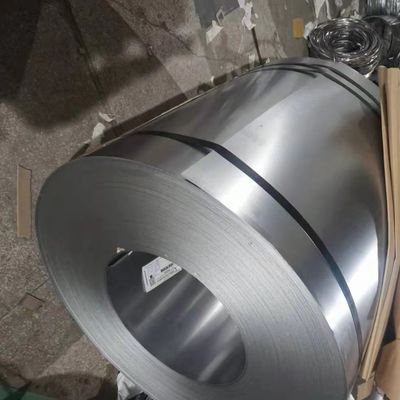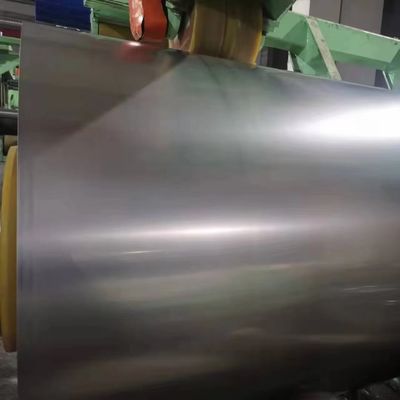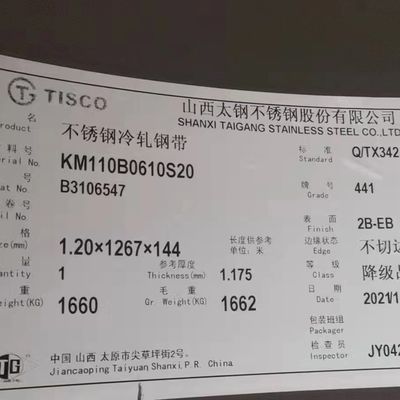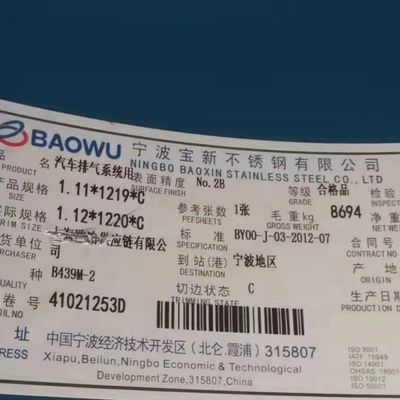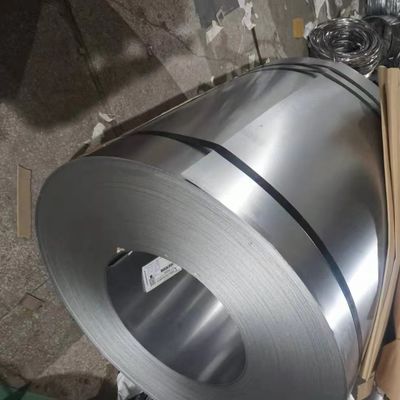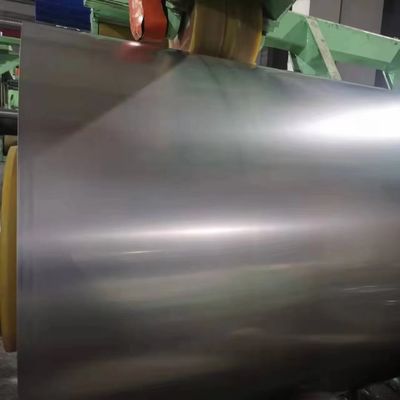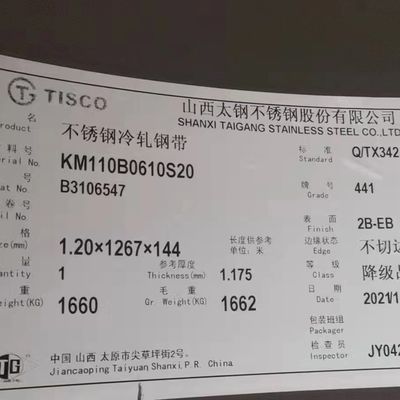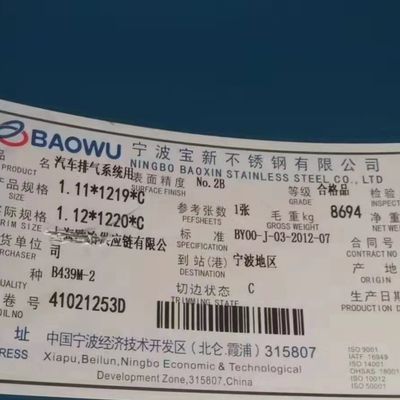-
 Raian IonescuMaterial quality very good. we have cooperate more than 10 Years. They trade lots kinds of steel material. All material quality good. They duty for all material quality. We are planing continue cooperate with them in the future
Raian IonescuMaterial quality very good. we have cooperate more than 10 Years. They trade lots kinds of steel material. All material quality good. They duty for all material quality. We are planing continue cooperate with them in the future
Cold Rolled 2D Surface Stainless Steel Sheet Grade 439 441 436L 409L SS Sheet for Exhaust Pipe
| Place of Origin | China |
|---|---|
| Brand Name | TISCO |
| Certification | ISO |
| Model Number | 409L 436L 439 441 |
| Minimum Order Quantity | 500 kgs |
| Price | 1220 - 1410 USD/Ton |
| Packaging Details | standard packing for export |
| Delivery Time | 5 - 12 days based on the quantity |
| Payment Terms | T/T, Western Union, L/C |
| Supply Ability | 10 Ton per week |

Contact me for free samples and coupons.
Whatsapp:0086 18588475571
Wechat: 0086 18588475571
Skype: sales10@aixton.com
If you have any concern, we provide 24-hour online help.
x| Products | Stainless Steel Sheet | Grade | Stainless Steel 409L 436L 439 441 |
|---|---|---|---|
| Standard | ASTM EN JIS GB | Size | 1219*2438mm |
| Thickness | 0.5 - 3.0mm | Type | Cold Rolled |
| Service | Cutting, Surface Treatment | Application | Auto Exhaust Pipe |
| Packing | Wooden Pallets | ||
| Highlight | cold rolled stainless steel sheet,stainless steel cold rolled sheet,cold rolled steel sheet |
||
Cold Rolled 2D Surface Stainless Steel Sheet Grade 439 441 436L 409L SS Sheet for Exhaust Pipe
Products Specification
| Products Name | 439 441 436L 409L Stainless Steel Sheet |
| Standard | ASTM EN JIS GB BIS |
| Thickness |
0.4mm 0.5mm 0.6mm 0.8mm 1.0mm 1.2mm 1.5mm 2.0mm 2.5mm 3.0mm 4.0mm 5.0mm 6.0mm 8.0mm 10.0mm 12.0mm |
| Surface | 2B 2D NO.1 or process other surface as request |
| Standard Size | 1219*2438mm 1000*2000mm |
| Service | Slit Cutting, bending , surface treatment |
| Other Grade | 200 Series: 201 202 |
| 300 Series: 301 304 304L 309S 310S 316L 316Ti 317l 321 329 347 | |
| 400 Series: 409L 410S 416 420 431 436L 439 441 443 444 446 | |
| Special Grade: 254SMO 904L 2205 2507 253MA Nickel Alloy | |
| MOQ | 500 kgs |
| Packing | Wooden Pallets and waterproof paper |
The 400 series group of stainless steels typically have an 11% chromium and 1% manganese increase, above the 300 series group. This stainless steel series tends to be susceptible to rust and corrosion under some conditions although heat-treating will harden them. The 400 series of stainless steels have a higher carbon content, giving it a martensitic crystalline structure that provides the end product with high-strength and high-wear resistance. The 400 series steels tend to be used in agricultural equipment, gas turbine exhaust silencers, hardware, motor shafts, and more.
WHAT IS FERRITIC STAINLESS STEEL?
While austenitic stainless steels are the most commonly used type, ferritic stainless steels are the next most widely used stainless steel. With low carbon levels, high chromium content, and containing no or very little nickel, ferritic stainless steels resist corrosion, are known for ductility, and have magnetic properties. Though not capable of hardening with heat treatment, with the annealing process, they can be softened, and cold worked. In stainless steel gradings, ferritic stainless steel is classified under the 400 series, while they’re further designated depending on application and composition into five groups.
TYPES & APPLICATIONS OF FERRITIC STAINLESS STEELS
Stainless steel grades with ferritic microstructures account for around 20 percent of all stainless steel tonnage produced. These ferritic steel alloys are generally classified into five groups. The first three types – groups 1-3 – are considered standard grades, while the last two types are specialty grades. Though the tonnage of standard grades produced is far more, demand for specialty grades increases steadily.
Grades of ferritic stainless steel and uses include:
- 409 stainless steel: Automotive exhaust systems, electrical kiosks and distribution boxes
- 430 stainless steel: Automotive trim, chimney liners, dish washer linings, fasteners, refrigerator cabinet panels and stove trim rings.
- 430LI stainless steel: Used for appliances, architectural screens, cooking utensils, fasteners, food processing and interior trim.
- 434 stainless steel: Architectural applications, automotive trim, dishwashers, downspouts and gutters, gas burners, heating units, oil refinery equipment, restaurant equipment, roofing and siding.
- 436L stainless steel: Automotive exhaust manifolds
- 439 stainless steel: Automotive exhaust manifolds, hot water tank components and residential furnaces, as well as in the chemical processing, petroleum refining and power generation industries.
- 441 Stainless Steel: Automotive exhaust manifolds, hot water tank components and residential furnaces, as well as in the chemical processing.
- 442 stainless steel: Food processing equipment, heavy gauge welded components, pharmaceutical processing equipment and surgical implants.
- 444 stainless steel: Cladding and roofing in marine environments, food processing equipment, hot water heaters and stainless steel tubing for heat exchangers.
- 446 stainless steel: Boiler components, burners, flame rods, injector nozzles for molten compounds and thermocouple protectors.
These grades are additionally classified according to the following five groups:
- Group 1 (includes SS409 and other grades) stainless steels are the least expensive, as they have the lowest chromium content of all ferritic stainless steel. It’s ideal for use in conditions that are only slightly corrosive and is used for stainless steel tubing for automotive exhausts, along with containers and frames for LCD monitors.
- Group 2 (includes SS430 and other grades) are the most commonly used of all ferritic stainless steels, with higher chromium content that makes it more corrosion-resistant against nitric acids, sulfuric gases, and many organic acids. It’s often found within the interiors of appliances, as well as cooking utensils and food production equipment.
- Group 3 (includes SS439 and other grades) stainless steels are more easily welded and formed, so can be used to replace stainless steel 304, an austenitic grade in some applications. Its uses include for stainless steel tubing for exchanges, exhaust systems, and welded washing machine components.
- Group 4 (includes SS434, SS444, and other grades) has a higher molybdenum content, giving it greater corrosion resistance. Because of this property, these grades often are used in outdoor environments, though applications also include electric kettles and elements in microwave ovens.
- Group 5 (includes SS446 and other grades) stainless steels contain high proportions of chromium, along with molybdenum. These specialty alloys offer excellent resistance against corrosion and oxidation, making them ideal for coastal and marine environments.
In general, the magnetic properties of ferritic stainless steel grades also make them ideal for fastening components and induction heating. Compared to austenitic grades, their higher thermal conductivity and lower thermal expansion coefficient make them suitable for cooking utensils and other applications where heat transfer occurs. Ferritic steels also have some distinctive properties that make them practical for use in the auto industry, along with nuclear reactors.
Some types of ferritic stainless steel offer sufficient corrosion resistance to replace austenitic stainless steel 304, which is used for dishwashers, food processing equipment, and kitchen sinks. Due to their strength, ferritic stainless steel pipes can handle high-pressure conditions like refineries. Additionally, certain specialty grades of ferritic stainless steel have higher chromium content, with added molybdenum to allow them to withstand corrosive marine conditions.
CHEMICAL COMPOSITION & GRAIN STRUCTURE
Stainless steels are described by their molecular composition, with ferritic steels built from microstructures called ferrite, which exists as a metallurgical phase of iron. Featuring numerous small crystals, ferrite is hard and brittle. It’s made up of iron oxide and at least one other metal in a chemical combination. This essentially makes it a solid solution.
While all stainless steels incorporate chromium, ferritic steels generally have higher chromium content. This is what gives it greater corrosion resistance, hardness, and glossiness when polished. Some ferritic stainless steels contain as much as 27 percent chromium. However, the main difference between austenitic and ferritic stainless steels is their nickel content. Ferritic stainless steels contain very little if any nickel, a trait similar to martensitic stainless steels. Another difference is their low carbon content.
Each stainless steel alloy differs from other types primarily in where the iron atom is positioned within the metal’s grain. Ferritic steels have a grain structure referred to as body-centered-cubic, while other types of stainless steel have face-centered grain structures. Body-centered-cubic grains are what give ferritic steel its magnetic properties, which differ from other stainless steel.
MAIN PROPERTIES OF FERRITIC STAINLESS STEEL
While heat treatment won’t harden or strengthen ferritic steels, they can be cold-worked and softened through an annealing process, which involves heating the metal and then slowly cooling it. Though they’re neither as strong nor as resistant to corrosion as austenitic steels, ferritic grades normally have more beneficial mechanical properties. They tend to be easy to weld, though some ferritic grades have limitations, restricting use of these steels to thinner gauges.
Because they don’t contain nickel and have lower amounts of chromium, standard ferritic stainless steels normally cost less than austenitic grades. The most widely used ferritic grade of stainless steel is SS430. With lower chromium content, SS409 is less corrosion-resistant. In contrast, SS439 resists corrosion better and is more stable in high temperatures.
Depending on the alloy, ferritic stainless steels exhibit several beneficial properties.
CORROSION RESISTANCE
Corrosive environments and tensile stress can cause steel to degrade, resulting in stress corrosion cracking (SCC). When exposed to chlorides, austenitic steels are particularly vulnerable to SCC. In contrast, ferritic steels resist SCC much better, making them suitable for applications and in environments that contain chlorides.
DUCTILITY AND FORMABILITY
The hardness of steel results from its carbon content, yet it also makes it more brittle and ductile. As ferritic stainless steel contains very little carbon, it is normally more ductile than other steel. This allows ferritic steels to be shaped without weakening. The low carbon content additionally means they have superior formability properties, so can be easily shaped with little potential for cracking or necking.
Low carbon content has some tradeoffs, however. The low carbon content makes it impossible to harden via heat treatments. Some ferritic stainless steel alloys also exhibit problems when welded, sometimes cracking unexpectedly along the heat-affect zone.
LOW THERMAL EXPANSION
With a low coefficient of thermal expansion, ferritic steels expand less as they’re heated. Since the metal retains a fixed dimension more easily, these stainless steels work well in high temperatures.
HIGH THERMAL CONDUCTIVITY
With excellent thermal conductivity properties, ferritic stainless steels allow heat to move efficiently through them. For this reason, they’re often used in boiler heat exchangers, furnaces, and in applications that involve heat transfer.
RESISTANCE TO OXIDATION
Ferritic stainless steel offers excellent oxidation resistance, especially at higher temperatures. This property is due to chromium-oxide film forming on the metal’s surface. Oxidation resistance can be further improved by utilizing aluminum and/or silicon during fabrication.
FERRITIC STAINLESS STEELS BY ATLANTIC STAINLESS
As stainless steel distributors, the Atlantic Stainless Company Inc. carries a diverse inventory of stainless steel products. One of our strengths is an expert sales staff boasting over 150 years of combined experience working with stainless steel. Suppliers of all grades of stainless steel, including ferritic grades within the 400 series, Atlantic Stainless serves local businesses and a global clientele.
Our selection of ferritic stainless steel products includes:
- Stainless steel fittings
- Stainless steel pipe
- Stainless steel plate
- Stainless steel round bar
- Stainless steel sheet
- Stainless steel square bar
- Stainless steel tubing
![]()
![]()
![]()
![]()



